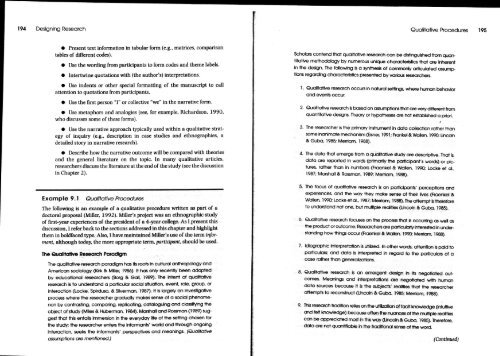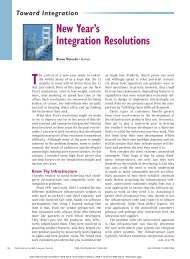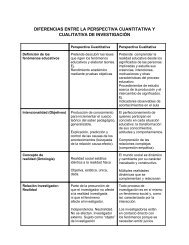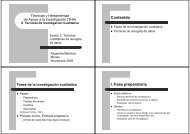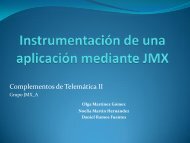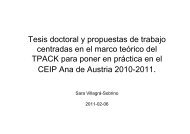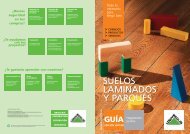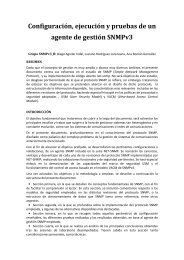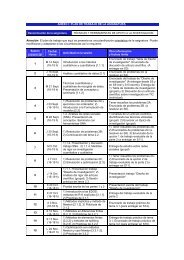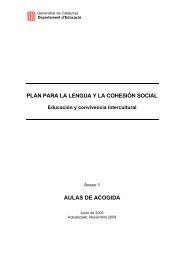Research Questions and Hypotheses
Research Questions and Hypotheses
Research Questions and Hypotheses
Create successful ePaper yourself
Turn your PDF publications into a flip-book with our unique Google optimized e-Paper software.
194 Designing <strong>Research</strong> Qualitative Procedures 195<br />
Present text information in tabular form (e.g., matrices, comparison<br />
tables of different codes).<br />
Use the wording from participants to form codes <strong>and</strong> theme labels.<br />
Intertwine quotations with (the author's) interpretations.<br />
Use indents or other special formatting of the manuscript to call<br />
attention to quotations from participants.<br />
Use the first person "I" or collective "we" in the narrative form.<br />
Use metaphors <strong>and</strong> analogies (see, for example, Richardson, 1990,<br />
who discusses some of these forms).<br />
Use the narrative approach typically used within a qualitative strategy<br />
of inquiry (e.g., description in case studies <strong>and</strong> ethnographies, a<br />
detailed story in narrative research).<br />
Describe how the narrative outcome will be compared with theories<br />
<strong>and</strong> the general literature on the topic. In many qualitative articles,<br />
researchers discuss the literature at the end of the study (see the discussion<br />
in Chapter 2).<br />
Example 9.1 Qualitative Procedures<br />
The following is an example of a qualitative procedure written as part of a<br />
doctoral proposal (Miller, 1992). Miller's project was an ethnographic study<br />
of first-year experiences of the president of a 4-year college..As I present this<br />
discussion, I refer back to the sections addressed in this chapter <strong>and</strong> highlight<br />
them in boldfaced type. Also, I have maintained Miller's use of the term informant,<br />
although today, the more appropriate term, participant, should be used.<br />
The Qualitative <strong>Research</strong> Paradigm<br />
The quctittative research paradigm has its roots in cultural anthropology <strong>and</strong><br />
American sociology (Kirk Miller, 1986). tt has only recently been adopted<br />
by educational researchers (Borg 8C Gall, 1989). The intent of qualitative<br />
research is to underst<strong>and</strong> a particular social sttuation, event, role, group, or<br />
interaction (Locke, Spirduso, & Silverman, 1987). lt is largely an investigative<br />
process where the researcher gradually makes sense of a social phenomenon<br />
by contrasting, comparing, replicating, catdoguing <strong>and</strong> classifying the<br />
object of study (Miles & Huberman, 1984). Marshall <strong>and</strong> Rossman (1989) suggest<br />
that this entails immersion in the everyday life of the setting chosen for<br />
the study; the researcher enters the informants' world <strong>and</strong> through ongoing<br />
interaction, seeks the informants' perspectives <strong>and</strong> meanings. (Qualitative<br />
assumptions are mentioned.)<br />
Scholars contend that qualitative research can be distinguished from quantitative<br />
methodology by numerous unique characteristics that are inherent<br />
in the design. The foliowing is a synthesis of commonly articuiated assumptions<br />
regarding characteristics presented by various researchers.<br />
Qualitative research occurs in natural settings, where human behavior<br />
<strong>and</strong> events occur.<br />
Qualitative research is based on assumptions that are very different from<br />
quantitative designs. Theory or hypotheses are not established a priori.<br />
The researcher is the priniary instrument in data collection rather than<br />
some inanirncrte mechanism (Eisner, 1991; Frankel & Wallen, 1990; Uncoln<br />
& Guba, 1985; Merriarn, 1988).<br />
The data that emerge from a qualitative study are descriptive. That is,<br />
data are reported in words (primarity the participant's words) or pictures,<br />
rather than in numbers (Fraenkel & Wallen, 1990; Locke et al.,<br />
1987; Marshall & Rossman, 1989; Merriam, 1988).<br />
5, The focus of qualitative research is on participants' perceptions <strong>and</strong><br />
experiences, <strong>and</strong> the way they make sense of their lives (Fraenkel &<br />
VVallen, 1990; Locke et al., 1987; Merriam, 1988). The attempt is therefore<br />
to underst<strong>and</strong> not one, but rnultiple realities (Lincoln & Guba, 1985).<br />
Qualitative research focuses on the process that is occurring as well as<br />
the product or outcome. <strong>Research</strong>ers are particulatiy interested in underst<strong>and</strong>ing<br />
how things occur (Fraenkel VVallen, 1990; Merriam, 1988).<br />
ldiographic interpretation is utilized. In other words, attention is paid to<br />
particulars; <strong>and</strong> data is interpreted in regad to the particulars of a<br />
case rather than generalizations.<br />
Qualitative research is an ernergent design in its negotiated outcomes.<br />
Meanings <strong>and</strong> interpretations are negotiated with human<br />
data sources because it is the subjects' realities that the researcher<br />
atternpts to reconstrucf (Lincoln & Guba, 1985; Merriam, 1988).<br />
This research tradition relies on the utilizalion of tacit knowledge (intuttive<br />
<strong>and</strong> felt knowledge) because often the mames of the multiple redilies<br />
can be appreciated most in this way (Lincoln & Guba, 1985). Therefore,<br />
data are not quanfifiable in the traditional sense of the word.<br />
(Continued)


